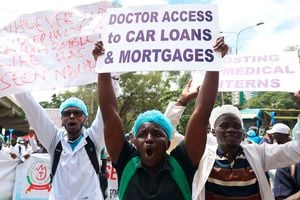What it will take to end doctors’ strikes once and for all

Hundreds of health workers participate in a demonstration in Nairobi on April 16, 2024.
What you need to know:
- The dilemma for doctors is that both action and inaction have ethical costs. Should they take industrial action, which will risk causing harm to patients (and their colleagues) in the short term?
- Or should they abstain, potentially leading to greater harm to themselves, their colleagues and patients?”
It is the celebrated former British prime minister Winston Churchill who opined that ‘you should never let a good crisis go to waste’. We are currently in week eight of the doctors’ strike, a strike that has seen clinical officers and medical lab technologists join the doctors in agitating for better employment terms.
But truth be told. The country has experienced constant health sector industrial disharmony since the birth of devolution. When not dealing with a nationwide strike, we are having prolonged county specific stand-offs left, right and centre. By the time the doctors' union issued the 2016/17 strike notice, the country had witnessed 43 strikes in just over three years across various counties. Not to mention labour-related court cases pitting the doctors’ union against county or national government entities.
Every time the discussion of doctors’ strike comes up, the first reaction is the tired line that “doctors are essential service providers who should not go on strike”. That they should settle their issues without making patients suffer. This line flies in the face of article 43 of the Constitution of Kenya and numerous human rights declarations.
The British Medical Association (BMA) says this in a communique to its members concerning engaging in a doctors’ strike: “Doctors have ethical responsibilities to protect and promote the welfare of their patients.
The dilemma for doctors is that both action and inaction have ethical costs. Should they take industrial action, which will risk causing harm to patients (and their colleagues) in the short term? Or should they abstain, potentially leading to greater harm to themselves, their colleagues and patients?”
A keen scrutiny of the various demands during the union’s existence will find cross-cutting issues wider than doctors’ remuneration. Besides, the said strikes happen when all alternatives have seemingly been exhausted. Currently, a signed and registered CBA has not been implemented for seven years. When the sacrosanct centre of employer-employee relations can no longer hold, things fall apart. The current and immediate past administrations have declared their commitment to universal health coverage (UHC). It is important to remember that UHC has key components in its very definition: it is universal (countrywide), focuses on populations’ access to healthcare needs and it must accord financial protection. How, then can we ensure the entire Kenyan population is assured of UHC in the framework of devolution?
We have witnessed a modus operandi where counties can fire doctors and go for months on end with crippled healthcare services. Devolution has created a healthcare caste system where some counties have made tremendous health gains while others have crippled their health sectors. How can a country achieve UHC in such an environment? Besides, devolution of health services may have precipitated marginalisation of certain societies in terms of healthcare access.
Picture this, data from the Kenya Medical Practitioners and Dentist Council (KMPDC) indicate that as of 2022, Nairobi County had 4,217 medical officers and 499 dentists while Samburu County had only 12 and 0 respectively! Five years into devolution! Six decades into independence! No Kenyan chose to be born in their respective counties.
To stem such inequalities, having a centralised body to handle the human resources for health (HRH) would offer a lasting solution. Not only will such a Health Service Commission (HSC) harmonise HRH distribution countrywide, but it would also handle promotions, training and staff disciplinary matters. Besides, a HSC should bring together all the health workforce cadres. If this strike is anything to go by, we are yet to see more cadres forming their own unions. Soon, we may have a union of radiographers and sonographers, nutritionists and physiotherapists besides the clinical officers, medical lab technologists and nurses. All these workers need to be brought into a harmonious industrial coexistence through a credible body that understands the intricacies of the various cadres.
With such a body, the HRH will be shielded from political regime changes. We have seen a governor fire doctors only for a new governor to reinstate them. Twice we have seen the national government disown or contest a signed CBA, claiming it was done by a different regime. We can learn from how the TSC has run the teachers HR matters in the era of devolution.
What then needs to be done? Recently, the majority leader in the National Assembly suggested enactment of an Act of parliament to create such a body. Coming hot on the heels of heated calls by opposition legislators for the resignation of the health CS, and cognizant that the Kenya Kwanza manifesto talked about such a commission, this will be a bipartisan walk in the park. Now is the opportune time. Our legislators should not let this health crisis go to waste!
Dr Aruyaru is a consultant general surgeon and the Chief Medical Officer at PCEA Kikuyu Hospital




